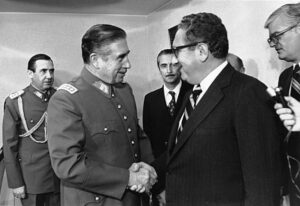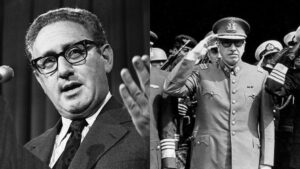Should George W. Bush, Dick Cheney and Others Be Jailed for War Crimes?
We need a full and public accounting of the CIA’s activities, the doings of military and civilian agencies and outfits, the White House’s drone assassination program, and the illegal, devastating invasion and occupation of Iraq. David Poe / (CC BY-ND 2.0)
1
2
3
David Poe / (CC BY-ND 2.0)
1
2
3
“The cold was terrible but the screams were worse,” Sara Mendez told the BBC. “The screams of those who were being tortured were the first thing you heard and they made you shiver. That’s why there was a radio blasting day and night.”
In the 1970s, Mendez was a young Uruguayan teacher with leftist leanings. In 1973, when the military seized power in her country (a few months before General Augusto Pinochet’s more famous coup in Chile), Mendez fled to Argentina. She lived there in safety until that country suffered its own coup in 1976. That July, a joint Uruguayan-Argentine military commando group kidnapped her in Buenos Aires and deposited her at Automotores Orletti, a former auto repair shop that would become infamous as a torture site and paramilitary command center. There she was indeed tortured, and there, too, her torturers stole her 20-day-old baby, Simón, giving him to a policeman’s family to raise.
Mendez was an early victim of Operation Condor, a torture and assassination program focused on the region’s leftists that, from 1975 to 1986, would spread terror across Latin America’s southern cone. On May 27th, an Argentine court convicted 14 military officers of crimes connected with Operation Condor, issuing prison sentences ranging from 13 to 25 years. Among those sentenced was Reynaldo Bignone, Argentina’s last military dictator, now 88. (He held power from 1982 to 1983.)
Those convictions are deeply satisfying to the surviving victims and their families, to the legal teams that worked for more than a decade on the case, and to human rights organizations around the world. And yet, as just as this outcome is, it has left me with questions — questions about the length of time between crime and conviction, and about what kinds of justice can and cannot be achieved through prosecutions alone.
Operation Condor
Operation Condor was launched by the security forces of five military dictatorships: Chile, Argentina, Uruguay, Paraguay, and Bolivia. Brazil soon joined, as did Ecuador and Peru eventually. As a Cold War anti-communist collaboration among the police, military, and intelligence services of those eight governments, Condor offered an enticing set of possibilities. The various services could not only cooperate, but pursue their enemies in tandem across national borders. Indeed, its reach stretched as far as Washington, D.C., where in 1976 its operatives assassinated former Chilean ambassador to the U.S. Orlando Letelier and his young assistant, Ronni Moffitt, both of whom then worked at the Institute for Policy Studies, a left-wing think tank.
How many people suffered grievously or died due to Operation Condor? A definitive number is by now probably beyond recovery, but records from Chile’s secret police suggest that by itself Argentina’s “dirty war” — the name given to the Argentine junta’s reign of terror, “disappearances,” and torture — took the lives of 22,000 people between 1975 and 1978. Thousands more are thought to have died before that country’s dictatorship ended in 1983. It’s generally believed that at least another 3,000 people died under the grimmest of circumstances in Chile, while thousands more were tortured but lived. And although its story is less well known, the similar reign of terror of the Uruguayan dictatorship directly affected the lives of almost every family in the country. As Lawrence Wechsler wrote in a 1989 article in the New Yorker:
“By 1980, one in every fifty Uruguayans had been detained at some point, and detention routinely involved torture; one in every five hundred had received a sentence of six years or longer under conditions of extreme difficulty; and somewhere between three hundred thousand and four hundred thousand Uruguayans went into exile. Comparable percentages for the United States would involve the emigration of thirty million people, the detention of five million, and the extended incarceration of five hundred thousand.”
And what was the U.S. role in Operation Condor? Washington did not (for once) plan and organize this transnational program of assassination and torture, but its national security agencies were certainly involved, as declassified Defense Department communications indicate. In his book The Condor Years, Columbia University journalism professor John Dinges reported that the CIA provided training for Chile’s secret police, computers for Condor’s database, telex machines and encoders for its secret communications, and transmitters for its private, continent-wide radio communications network. Chilean Colonel Manuel Contreras, one of Condor’s chief architects (who was then on the CIA payroll), met with CIA Deputy Director Vernon Walters four times. And what did the CIA get in return? Among other things, access to the “results” of interrogation under torture, according to Dinges. “Latin American intelligence services,” he added,
“considered U.S. intelligence agencies their allies and provided timely and intimate details of their repressive activities. I have obtained three documents establishing that information obtained under torture, from prisoners who later were executed and disappeared, were provided to the CIA, the FBI and the DIA (Defense Intelligence Agency). There is no question that the U.S. officials were aware of the torture.”
Justice Delayed
Why did it take 40 years to bring the architects of Operation Condor to justice? A key factor: for much of that time, it was illegal in Argentina to put them on trial. In the first years of the new civilian government, the Argentine congress passed two laws that granted these men immunity from prosecution for crimes committed in the dirty war. Only in 2005 did that country’s supreme court rule that those impunity laws were unconstitutional. Since then, many human rights crimes have been prosecuted. Indeed, Reynaldo Bignone, the former dictator, was already in jail when sentenced in May for his role in Operation Condor. He had been convicted in 2010 of kidnapping, torture, and murder in the years of the dirty war. As of March, Argentina’s Center for Legal and Social Studies (CELS) had recorded 666 convictions for participation in the crimes of that era.
Your support matters…Independent journalism is under threat and overshadowed by heavily funded mainstream media.
You can help level the playing field. Become a member.
Your tax-deductible contribution keeps us digging beneath the headlines to give you thought-provoking, investigative reporting and analysis that unearths what's really happening- without compromise.
Give today to support our courageous, independent journalists.







You need to be a supporter to comment.
There are currently no responses to this article.
Be the first to respond.